Building a Library of Samples and Swatches
Have you ever noticed how often classes and workshops include samples or swatches? We make practice pieces to master a new technique and make gauge swatches to choose the size of our knitting needles, crochet hooks, or the reed for our loom. These little bits of fibre, yarn, and cloth tend to pile up until we reach our breaking point. I know some people find functional uses for the little bits, using them as washcloths, and some people just get rid of them, but is there a good reason to keep them?
Curating Your Library
I work in a small room with a large loom, so space is at a premium. Having a clear idea about WHY I want to collect samples is important so I can easily prioritize which ones to keep.
The swatches and samples I have fall into three groups:
- As a record of what I am learning or making for a specific project or class
- As a record of a technique or idea
- As a reference sample for a fibre, yarn, or fabric
As hobbyists, the most ubiquitous reason to make a swatch or sample is for a project, but if you are anything like me, you won’t refer to it at all after the project is finished! Whether you keep these kinds of swatches and samples depends on where you are at in your making journey and why you made the project originally. What I do regularly refer to are samples that I have kept as a design aid (like gamps) or as a learning aid.

Don’t be afraid to touch the fibres and contrast them with each other.
Samples as a Learning Aid
I use my library of swatches and samples to deepen my understanding of textiles. By looking closely and learning to recognize the small differences between fibres, yarns, and fabric structures, I can better apply the knowledge I gain to the things I make. So much of what we do when we work with textiles relies on our experiences, and so it takes deliberate time and practice to recognize what we want from a design and then what materials and techniques we should use to make that design a reality. Learning the vocabulary is important, but training our eyes and hands is just as valuable, and that is what I use my samples for.
One way to use samples is to deconstruct them in order to work out how they were made. I find this an excellent exercise to do with both handmade and industrially made swatches and samples. If you have samples of woven or knit cloth, you can use a magnifying lens to analyze the interlacements and draw up a weaving draft or knitting chart of your own. If you have samples of yarn, you could reverse-engineer it to figure out what fibre and how much twist it needed to create the yarn. You could even look at how a seam was constructed or how embroidery thread weaves in and out of the ground cloth to figure out how to do the technique yourself.

Samples as a Design Aid
Depending on what you are trying to record and what you are trying to do with your samples, swatches may not need to be very big—perhaps just big enough to cover a few repeats. I keep larger samples to learn and understand more about properties like drape (how the textile hangs) and hand (how the fibre feels to the touch). This kind of larger quality reference sample is great when learning about and deciding on the suitability of a particular fibre or fabric for a particular application, such as whether your cloth would withstand wear-and-tear as a pair of trousers or whether your yarn is next-to-the-skin soft.
One of my long-term goals is to make garments from handwoven and handknit cloth, culminating in a coat from handspun wool. I want to understand the effects of the decisions I make, from fibre and yarn type to fabric weight to construction and finishing techniques. This is my motivation for collecting samples and trying new techniques.
Do you have a long-term goal that would benefit from a library of samples to study? Maybe you have other reasons for keeping samples? How has playing and looking more closely at fibre, yarn, and fabric made a difference in how you approach textiles? Share your thoughts over on the School of SweetGeorgia forums or on the SweetGeorgia Discord channel.
Original publication: September 15th, 2022; Refreshed: January 14th, 2025
The post Building a Library of Samples and Swatches appeared first on SweetGeorgia Yarns.
Comments
Post a Comment